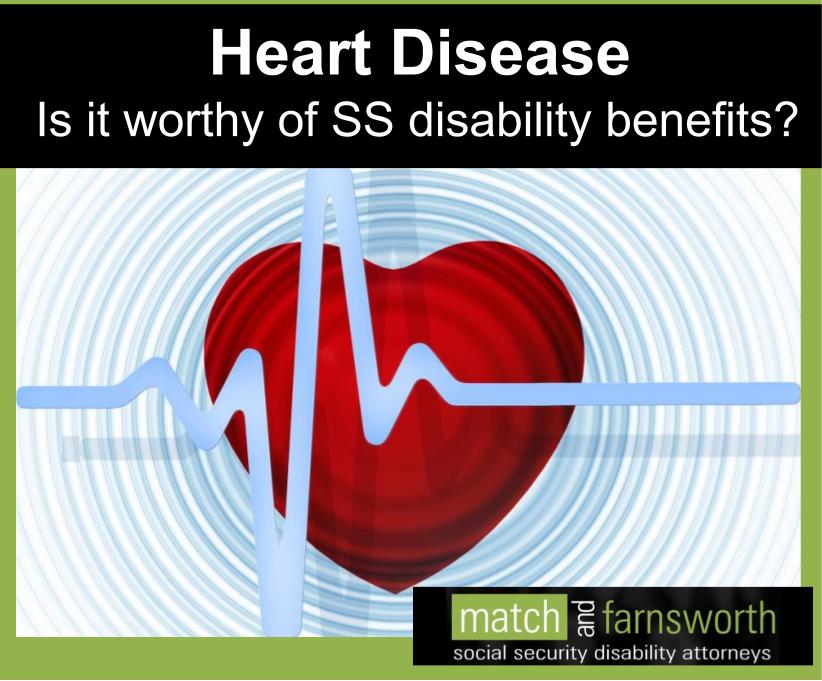If you have a heart condition that makes it difficult or impossible to work, you may want to consider applying for Social Security Disability benefits. Even if you do not have a long work history, you may be eligible for benefits, or for Supplemental Security Income (SSI). But, before you start a claim, you will want to understand whether or not your condition is considered disabling. Even if you feel you cannot work, Social Security may not agree, and their rules are very complex. It is a good idea to consult with a knowledgeable attorney who has experience in Social Security Disability law. Match Disability Law, P.C., helps people with heart conditions claim their benefits in Arizona, Idaho, Nevada and Utah.

Social Security uses a 5 Step Process to determine whether or not you are eligible for their benefits. Part of this process is investigating your medical condition and deciding if it meets a Listing. The listings are a set of impairments that if your condition meets their specific criteria, you are automatically determined to have a medical impairment. This is important because it can shorten the processing time of your claim, and allow you to start receiving benefits much sooner, than if you need to prove that your condition keeps you from any doing any work.
The listings for heart conditions include Chronic heart failure, Ischemic heart disease, Recurrent arrhythmias, Symptomatic congenital heart disease, Heart transplant, Aneurysm of aorta or major branches, Chronic venous insufficiency, and Peripheral arterial disease. Included in the category of cardiovascular impairment is any disorder that affects the proper functioning of the heart or the circulatory system. The disorder can be congenital or acquired. You’ll find detailed explanations for the first two disorders below, and the others can be found in our additional posts – Cardiac Impairments part 2, Cardiac Impairments part 3.
In order to qualify under chronic heart failure, you must have a medically documented presence of either systolic failure or diastolic failure, which results in persistent symptoms that seriously limit your ability to perform activities of daily living , or three or more heart attacks within a year, or be unable to perform on an exercise tolerance test due to fainting, fatigue, palpitations, ventricular tachycardia, significant decrease in systolic blood pressure, or significant loss of blood flow to the brain.
To be found disabled under Ischemic heart disease, you must demonstrate the following signs or symptoms at a 5 METs or less workload during an exercise tolerance test. Horizontal or down-sloping depression of the ST segment of at least -0.10 millivolts (-1.0 mm) in at least 3 consecutive complexes that are on a level baseline in any lead other than a VR, and depression of at least -0.10 millivolts lasting for at least 1 minute of recovery; or at least 0.1 millivolt (1 mm) ST elevation above resting baseline in non-infarct leads during both exercise and 1 or more minutes of recovery; or decrease of 10 mm Hg or more in systolic pressure below the baseline blood pressure or the preceding systolic pressure measured during exercise due to left ventricular dysfunction, despite an increase in workload; or documented ischemia at an exercise level equivalent to 5 METs or less on appropriate medically acceptable imaging, such as radionuclide perfusion scans or stress echocardiography.

Ischemic heart disease will also meet the listing if you can show three separate ischemic episodes, each requiring revascularization or not amenable to revascularization within a consecutive 12-month period. Or, coronary artery disease, demonstrated by angiography or other appropriate medically acceptable imaging, and in the absence of a timely exercise tolerance test or a timely normal drug-induced stress test, an MC, preferably one experienced in the care of patients with cardiovascular disease, has concluded that performance of exercise tolerance testing would present a significant risk to the individual, with both angiographic evidence showing 50 percent or more narrowing of a nonbypassed left main coronary artery; or 70 percent or more narrowing of another nonbypassed coronary artery; or 50 percent or more narrowing involving a long (greater than 1 cm) segment of a nonbypassed coronary artery; or 50 percent or more narrowing of at least two nonbypassed coronary arteries; or 70 percent or more narrowing of a bypass graft vessel; and resulting in very serious limitations in the ability to independently initiate, sustain, or complete activities of daily living.
As you have read through the descriptions, you might realize that Social Security is very specific and demanding in the medical tests and records required to meet a listing. It is often the case that even with a severe disorder you will be denied benefits when you first apply. This is why having an attorney assist you with your claim for Social Security benefits is important. Not only do the attorneys at Match Disability Law, P.C., have experience in navigating the complex process of applying for benefits, but they also have years of experience in obtaining, explaining, and submitting medical records with easy to understand advocacy that can help Social Security realize the severity of your condition and grant your claim sooner.

